“Making
the word of God of none effect through your tradition, which ye have
delivered.”
(Mark
7:13)
Tradition
Dear Friends,
Greetings! This week we are featuring a radio interview with Robert Allen from “People of the Keys”. Robert was interviewed by Simon Peterson for his 'NightLight' program which is part of www.radioact.org.
Simon is a long time missionary who has spent decades in Asia and Africa. The show originates from Uganda.
The interview centers around the coming “Third Temple” and its importance in End Time events. We have posted several articles concerning this subject.
Following the interview is additional material which we have not posted, along with links to pertinent previously posted material concerning the coming Temple in Jerusalem.
We hope you find the information interesting and informative.
Have a wonderful week ahead.
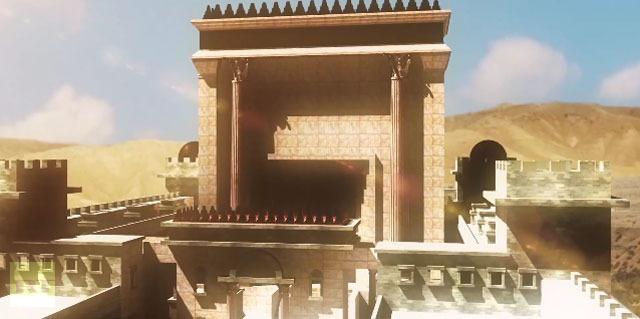
Introduction to “The Coming Temple”
1) Tradition
Tradition is defined to be "the delivery of opinions, doctrines, practices, rites, and customs from generation to generation by oral communication. It is an inherited, established, or customary pattern of thought, action, or behavior (as a religious practice or a social custom)". It is in theology, an unwritten saying, action or a code of laws attributed to the founder and the earlier promoters of a religion. It is derived from the Latin "traditio", meaning "action of handing over", from "tradere", to deliver.
2) A Few examples of some well known traditions
A) Christmas
falls on December 25 – See “The Star of Bethlehem”.
“And there were in the same country shepherds abiding in the field, keeping watch over their flock by night.” Luke 2:8 Generally speaking flocks are not kept outside in December in Israel. It is too cold.
In 168 B.C.E., on December 25th, Zeus' (Satan) birthday, Antiochus Epiphanes IV set up in the Jerusalem Temple a statue of Zeus, the Greek sun god, upon the altar, defiling it.
B) The Christmas tree - is not found in the Bible, but another tree is found in Jeremiah 2:2-4
“Thus saith the Lord, Learn not the way of the heathen, and be not dismayed at the signs of heaven; for the heathen are dismayed at them. For the customs of the people are vain: for one cutteth a tree out of the forest, the work of the hands of the workman, with the axe.
They deck it with silver and with gold; they fasten it with nails and with hammers, that it move not.”
C) For many people it's not quite Christmas without snow,- another tradition. The song “White Christmas” is one of the biggest selling songs of all times
D) Christmas cards and songs with animals. There may have been animals nearby, but they are not mentioned in the Bible.
E) Crucification and Resurrection -
“For as Jonas was three days and three nights in the whale's belly; so shall the Son of man be three days and three nights in the heart of the earth.” Matthew 12:40
Christians the world over celebrate “Good Friday” as the day Jesus was crucified, and Sunday as the day He rose from the dead.
The simplest math will show you that if He was crucified on Friday, He spent Friday night, Saturday night and rose on Sunday that is only two nights. Jesus was very specific in Matthew 12:40; He said three nights.
The truth is He was not crucified at the start of the Jewish sabbath, which begins Friday at sundown. He was crucified on the Passover which does not necessarily occur on a Friday. If He did rise on the Sunday, to spend three days and three nights in the heart of the earth He would have had to been crucified on a Thursday.
Jesus had something to say about traditions in Mark 7:1, 5-9,13
“Then came together unto him (Jesus) the Pharisees, and certain of the scribes, which came from Jerusalem. (and) asked him, Why walk not thy disciples according to the tradition of the elders,
He answered and said unto them, Well hath Esaias prophesied of you hypocrites, as it is written, This people honoureth me with their lips, but their heart is far from me.
Howbeit in vain do they worship me, teaching for doctrines the commandments of men. For laying aside the commandment of God, ye hold the tradition of men,
And he said unto them, Full well ye reject the commandment of God, that ye may keep your own tradition. Making the word of God of none effect through your tradition, which ye have delivered: and many such like things do ye.
Tradition can be a major obstacle in knowing and understanding the truth.
Most of the traditions we have discussed thus far are fairly benign in nature.
Why should we concern ourselves with the coming Temple?
Are there any traditions that could actually be dangerous?
Yes, and one of the most important and dangerous traditions concerns the rebuilding of what is commonly called the “Third Temple” in Jerusalem.
The area where the Jewish nation and the majority of Christians believe Solomon's Temple and Herod's Temple once stood is located is over a rock where the Mosque of Omar now stands inside the Haram Al-Sahrif which also contains the Al-Aqse Mosque.
This is the most disputed property on earth!
Why is that Temple so important?
It is the heart and soul of the entire Middle East conflict... The Lord only knows how many have died because of this conflict.
The Jews believe the Temple needs to be rebuilt before their Messiah can arrive.
Materials for the building of the Temple are already in warehouses, vestments already prepared, corner stone already cut, etc.

What if the commonly held belief that the Temples were built over the rock where the Dome of the Rock now stands is also wrong.
What if that belief were in part a tradition and not in fact born of truth.
Matthew 24:2 is a key verse in helping to evaluate the veracity of this belief.
1 And Jesus went out, and departed from the temple: and his disciples came to him for to shew him the buildings of the temple.
2 And Jesus said unto them, See ye not all these things? verily I say unto you, There shall not be left here one stone upon another, that shall not be thrown down. Is this a true prophecy or a false prophecy?
This is a direct prophecy uttered by Jesus to His disciples.
Revelation 19:10 tells us; for the testimony of Jesus is the spirit of prophecy.
If the western, “wailing wall” is a part of Harrod's Temple then Jesus gave a false prophecy. He said “There shall not be left here one stone upon another, that shall not be thrown down.” Not one!
(There are some who do not claim the wall to be part of the Temple but a retaining wall for the ground on which the Temple was built.)
If Jesus' prophecy is a true prophecy that wall cannot be part of the Temple.
That wall is actually part of the Fortress of Antonia where Titus housed his Legion of 5000 men plus 5000 support staff from where he razed the Temple to the ground leaving not one stone upon another.
The coming rebuilt Temple is also very important because Jesus warned us in Matthew 24:15, 21: “When ye therefore shall see the abomination of desolation, spoken of by Daniel the prophet, stand in the holy place, (whoso readeth, let him understand:) For then shall be great tribulation, such as was not since the beginning of the world to this time, no, nor ever shall be”.
This is a critical point that marks the beginning of the Great Tribulation, the 1260 days mentioned in Revelation 11 and 12, the 42 months mentioned in Revelation 13, and the time, times, and the dividing of time spoken of in Daniel 7:25.
Incidentally, the quote Jesus is using is found in Daniel 11:31:
“And arms shall stand on his part, and they shall pollute the sanctuary of strength, and shall take away the daily sacrifice, and they shall place the abomination that maketh desolate.”
Another verse that pertains: “And he (the anti-christ) shall plant the tabernacles of his palace between the seas in the glorious holy mountain.” The glorious holy mountain in scripture always refers to Mt. Zion where the original Temple and the original City of David resided.
How the “rock” under the Dome of the Rock came to be believed to be the location of Solomon's Temple
The Muslim account of the fourteenth century titled Muthir al-Ghiram summarizes early events at the beginnings of Islam by stating that Omar, the Second Caliph [the second successor to Muhammad], came to Jerusalem in 638 C.E. Seeking to pray at the place where King David erected the altar that became the site of the Temple. This historical record states that Omar had been given a divine revelation from God (so this account relates) wherein the prophet Muhammad showed him the area from whence Muhammad ascended from the “Farthest Masque” and into heaven. The Christian authority in charge of Jerusalem at this period was Sophronius, the patriarch of the Church of the Holy Sepulcher, was summed to a conference by Omar.
Sophronius was well aware of the spot the Jews had claimed for their Temple site, but since the time of Hadrian the area had been turned in the city dump (and was reconfirmed as a dump in the time of Constantine).
The area for all practical purposes was vacant and was a place where people of Jerusalem cast their refuse.
Sophronius then took Omar and his associates to the place where the Jews believed the Temple site was. The spot was just above and near the Gihon Spring. [Then] Sophronius pointed out to Omar ...the place where David prayed. [There was a rock]a portable stone. It was not a permanent outcropping of rock like under the Dome of the Rock.
The “rock” in Eutychius” account was actually a “stone” that could be carried by humans. Omar even took that particular “rock” and carried to into the region of the Haram esh-Sharif. He then made this portable “rock” part of his qibla area in what was to become known as the Al Aqse Mosque.
(Later Jewish records state that an elderly Jewish man helped Omar discover a stone underneath the refuse that represented where the Holy of Holies once stood.)
[The stones] were from the previous Temple begun at the time of Julian the Apostate (362 C.E.)
The “Stone” Was Transferred to the Haram esh-Sharif
With the discovery of the “stone” from what Omar thought was the site of Solomon's Temple, he looked around that part of Jerusalem for the place to build his shrine or mosque as he had been told to do in his vision. Omar then looked north at the southern wall of the Haram esh-Sharif where he saw a gate allowing entrance into the enclosure. This southern gate was particularly important to Omar because of a prime teaching of Islam that was beginning to circulate at this period.
It concerned an account of Muhammad's vision of a Night Journey on his fabled horse named Buraq. A cardinal factor of the story was a southern gate through which Muhammad was supposed to have entered an enclosure from whence he went to heaven. Omar thought that this southern gate of the Haram might be the one associated with the Night Journey of the Prophet.
Omar and Sophronius took the “stone” from the Jewish Temple site south of the Haram and with the other Muslims went through the southern gate in the Haram. Omar looked at the geographical factors of the spot and came to the conclusion that this was the region shown in his vision associated with Muhammad's Night Journey. It was the spot he wanted to build his Mosque.
Omar then named the southern gate of the Haram the Bab al-Nabi (the Gate of the Prophet) in dedication to the holy event of the site as Omar judged it, he then placed the “stone” from the southern Temple Mount to this southern part of the Haram esh-Sharif. He put it at the southern end of the building and it became a part of the qibla that pointed toward Mecca. This was the place that finally became the Al Aqse Mosque.
This moving of the “stone” to the inside southern wall of the Haram (along with many other rectangular stones used for building purposes) answered to an official relocating of the holiness of Solomon's Temple from its former spot over the Gihon Spring to this new site about 800 feet north. That is why it became common after the time of Omar by most people in Jerusalem to view the Al Aqsa Mosque as the pace of “Solomon's Temple.”
During the Crusades, the Christians finally had enough historical sense to abandon their belief that the Church of the Holy Sepulcher had had been part of Herod's Temple. They then joined the Muslims and took it for granted that the building the Al Aqse Mosque was the place where Solomon's Temple once stood.
The Abbasid Dynasty
The importance of the “Rock” under the Dome of the Rock changed dramatically and swiftly with the Abbasid Dynasty beginning in 750 C.E. Not only the footprints of Jesus (and even God's) were believed to be on the “Rock” but Muhammad's footprints (and also his handprint) were discovered near 750 C.E. These new “facts” proved to many Muslims that Muhammad's famous Night Journey to heaven took place on the “Rock,” and not at the Al Aqsa Mosque. From then on, a flood of folklore traditions descended upon the “Rock” that caused the Muslims to transfer almost all the events associated with the former Jewish Temple to the “Rock,”. It has remained that way ever since.
Taken from “The Temples that Jerusalem Forgot” by Ernest L. Martin pages 114-134.
Koinonia House
Tisha B'Av and The Coming Temple
from the July 02, 2013
The Hebrew month of Av begins Sunday night, July 7th, and Jews will mourn through the final nine day of The Three Weeks of grief that began with the Fast of Tammuz and end with Tisha b’Av—the day commemorating the destruction of the Jewish temples.
All public transportation will be silenced, all restaurants will remain closed in Jerusalem the evening of July 15th as the sun sets. The Hebrew day of great tragedies, Tisha b’Av, will begin at sundown. In remembrance of the destruction of both the First and Second Temple on the 9th of Av hundreds of years apart, tens of thousands of Jews will gather at the Western Wall to pray and petition the God of Abraham, Isaac, and Israel. Jewish hearts around the world will long in unison for the future Temple, the one to be established when the Messiah comes.
The Temple Mount
These next weeks, Jews look toward the Temple Mount with even more longing than normal. Israel has technically controlled the Temple Mount since the Six-Day War in 1967, but the Waqf, a Muslim council, manages the site. The Temple Mount is noticeably dominated by the al-Aqsa Mosque and the Dome of the Rock. Israeli law is supposed to protect free access to the site, but the Israeli government enforces a ban on any non-Muslim prayer on the site in order to avoid Muslim riots.
Many Jews look forward to the day when the Messiah will come, when the Temple will once again rise up on the Temple Mount. A video by The Temple Institute shows a little boy and girl playing on the beach and building a replica of the Temple in the sand. The end caption reads, “The Children Are Ready.” The video had more than 400,000 views on YouTube after it was released last year.
Rabbi Chaim Richman of the Temple Institute has long promoted this as a time of expectation for the Temple, rather than a time of mourning. This year in an article on the Fast of Tammuz and the beginning of the Three Weeks of mourning, Rabbi Richman wrote recently in The Jerusalem Post:
The fabricated tears of Tamuz are the romanticization of pain; being comfortable with the pain because it is what we are used to. This is what Maimonides alludes to. We can become so stuck in a place, so part of the cycle, that there is no way out of it.
But the whole idea of Tamuz is for us to confront those idolatrous forces within our own psyche. Parts of the Jewish mindset have been taken over. We have been lobotomized by the pagan mindset of weeping over Tamuz. The verse in Ezekiel [8:14] alludes to the weeping over our own lives, the tragic aspects of our lives, because self-pity feels so good. So we do it again and again, year after year.
Mourning for the Temple is not about crying over the past, or obsessing about something we cannot change; it is about becoming motivated to rise up from mourning, to transform this world into a place for the Divine Presence.
Holy Ground
While many patiently anticipate the coming Temple, not all Jews want worshipers, Jewish or Muslim, flooding the Temple Mount. Nobody is certain exactly where the Holy of Holies in the Temple was located, and these faithful Jews do not want the unwitting visitor to tread on that spot. Worshipers must first be cleansed with the ashes of the red heifer as required in Numbers 19 before Jews can worship freely in the Temple area.
East Jerusalem and the Temple Mount have been points of major contention in past efforts to negotiate a two-state agreement. The Palestinians want East Jerusalem, and the Jews do not want to give up this location that is so precious to Judaism. The world would never expect the Muslims to hand over control of the Kaaba in Mecca in order to keep peace, but the Jews are not free to worship on their holiest site because they fear Muslim violence.
Tisha B’Av
Many disasters have befallen the Jews on the 9th of Av throughout history. According to Jewish tradition, this was the day that God told the Children of Israel they were prohibited from entering the Promised Land because of disbelief. They were forced to wander in the desert forty more years until that adult generation had died out. That tragic day was just the beginning…
On the 9th of Av in:
586 BC, Solomon’s Temple was destroyed by Nebuchadnezzar, and the Babylonian captivity began;
AD 70, the Second Temple, which stood during Christ’s ministry, was destroyed by the Romans precisely as Jesus predicted in Luke 19;
AD 135, the famous Bar Kokhba revolt was squelched when Bethar, the last Jewish stronghold, fell to the Romans;
AD 136, the Roman Emperor Hadrian established a heathen temple to Jupiter on the site of the Jewish Temple. Hadrian rebuilt Jerusalem as a pagan city, and renamed the land as Palestina, to distance its Jewish heritage. The date when the Temple area was plowed under by the Romans was the 9th of Av.
The day has continued to be associated with grief for the Jewish people throughout history. For example, Pope Urban II declared the Crusades on the 9th of Av in 1242. Accordingt to the Alhambra Decree, the Jews were expelled from Spain in 1492 on this day (the same day that Columbus left on his westward route to the Indies). On the 9th of Av in 1942, the Jews in the Warsaw Ghetto were mass deported to the Treblinka extermination camp in Poland. Thus the 9th of Av, Tisha B’Av, has become a symbol of all the persecutions and misfortunes of the Jewish people, for the loss of their national independence and their sufferings in exile. Above all, it is a day of intense mourning for the destruction of the Temple.
A Day of Mourning… And Future Joy
Tisha b’Av is marked with sadness and fasting from food and drink. Observant Jews avoid bathing or washing clothes or enjoying entertainment like music or movies. On this day the Jews are reminded of their tragic history.
Yet, this day is also expressly linked with Israel’s glorious destiny. The Jews also look forward to the ultimate rebuilding of the Temple, to a time when Tisha b’Av will become a day of joy and gladness (as it was foretold in Zechariah 8:19).
We do know that the Temple will be rebuilt because Jesus, John, and Paul all make reference to it (Matt 24:15; Rev 11:1, 2; 2 Thess 2:4). We also know that a future Temple will be desecrated by the Coming World Leader when he sets himself up to be worshiped (2 Thess 2:3–4). It is possible this prophetic event will also take place on Tisha b’Av—and may happen in the not-too-distant future.

Talk of the Planet
New Video Series on Laws of the Third Temple for ‘The Nine Days’
By Dovid Zaklikowski
July 8, 2013

A new series of video classes on the erecting and observances of the Holy Temple in Jerusalem—developed for study during the first nine days of the Hebrew month of Menachem Av—is now available on Jewish.tv, the multimedia portal of Chabad.org.
The classes are delivered by the noted scholar and teacher Rabbi Yehoshua B. Gordon, director of Chabad of the Valley in Tarzana, Calif. They include the daily study of each of the eight chapters of Hilchot Beit Habechirah, the laws of building the Holy Temple, which are included in the Mishneh Torah, Maimonides’ monumental compendium of Jewish law.
The classes have been highlighted for study during the “Nine Days,” a period of additional mourning during the three week period of observance that marks the destruction of the first and second Holy Temples. The nine day period began on the first day of the Jewish month of Menachem Av (Monday, July 8, 2013) and concludes with the fast day of Tisha B'Av, the ninth day of Menachem Av, which will be observed this year from the evening of Monday, July 15, until the evening of Tuesday, July 16.
“The Rebbe especially encouraged people to learn these laws during the Nine Days, when we mourn the destruction of the Holy Temple,” says Gordon, referring to the call to study by Rabbi Menachem M. Schneerson, of righteous memory.
Gordon explains that “the Rebbe put tremendous emphasis on these laws” because studying them will hasten the Messianic era and the rebuilding of the Third Holy Temple. The Rebbe would often emphasize that “the best way to mourn the destruction is to learn about the imminent rebuilding.”
Quoting the Jewish sages in Midrash Tanchuma on Leviticus:14, G-d’s response to Ezekiel, who asked what could be done about the fact that the Jews do not have a Temple to go to in Jerusalem, the Rebbe noted that “the study of the design of the Holy Temple as detailed in the biblical verses can be equated to its actual construction.”
As explained in the introduction to the tour of the Holy Temple on Chabad.org, implicit in the wording used in this passage is the idea that studying the laws of the Holy Temple has ramifications that extend far beyond the ordinary sphere of intellectual activity.
The daily video class and the entire series are now available for viewing and study on Jewish.tv. To accompany the study, the full text of each chapter of Hilchot Beit Habechira is available on Chabad.org in English and in the original Hebrew.
The video series is the newest addition to the popular daily Torah-study classes, Rabbi Gordon Live! that are available on Jewish.tv. The series includes Chumash with the commentary of Rashi; Tanya, the seminal work of Chabad Chassidic philosophy; and the daily study of one chapter a day of the entire Mishneh Torah, which was introduced recently at the beginning of the new three-year cycle of daily study.
Karaite Views on the Mishnah
Karaites do not accept the existence of an Oral Law because:
1. The Mishnah quotes many conflicting opinions.
2. The Mishnah does not go on to say in which opinion the truth lies. Rather, the Mishnah sometimes agrees with neither one nor the other, contradicting both.
3. They argue that the truth of the oral law given to Moses could only be in one opinion, not many opinions.
4. They question why the Mishnah does not solely speak in the name of Moses.
5. The Oral Law is not explicitly mentioned in the Tanakh.
6. When God told Moses to come up to Mount Sinai to receive the Torah He said, "Come up to me into the mountain, and be there: and I will give you tablets of stone, and a law, and commandments that I have written"; (Ex 24:12). The text states the commands are written, and no mention is made of an Oral Law.
7. The Tanakh reports that the written Torah was both lost and completely forgotten for over 50 years and only rediscovered by the Temple priests (2Ki 22:8; 2Chr 34:15). It is inconceivable that an Oral Law could have been remembered when even the written Law was forgotten.
8. The words of the Mishnah and Talmud are clearly the words of people living in the 2nd - 5th centuries CE, in contrast to the Torah, which is held to be a direct revelation by God through Moses.
9. The Torah states, "You shall not add to the word that I am commanding you, nor take away from it, that you may keep the commandments of YHWH, your God, which I command you." (Deut 4:2) They argue that this excludes the possibility of later interpretation, when that interpretation is viewed as divinely ordained.
10. Joshua 8:34 - 35 states:
After that, he [Joshua] read all the words of the Torah, the Blessing and the Curse, according to all that is written in the Torah scroll. There was not a word of all that Moses had commanded that Joshua failed to read in the presence of the entire assembly of Israel, and the women, and the little ones, and the strangers that walked among them.
Since Joshua read from the Torah every word Moses had written, this implies that Moses had not been given an Oral Law, since Joshua could not have read an Oral Law from the written Torah. Secondly, there could not have been additional commandments outside of the written Torah, since all the commandments that existed could be read from the Torah scroll.
In addition to this, Joshua 1:8 states: This book of the law is not to depart out of your mouth, but you are to meditate on it day and night, so that you may observe to do according to all that is written in it.
The Times Of Israel
Minister calls for third Temple to be built
Potentially explosive statement by Jewish Home’s Uri Ariel breaks taboo against damaging status quo on Temple Mount
By TIMES OF ISRAEL STAFF
July 5, 2013
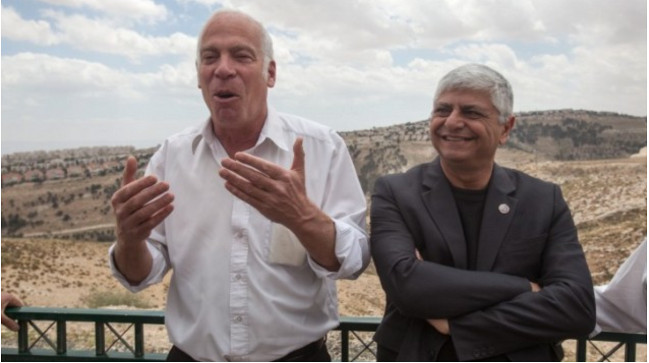
Minister of Housing and Construction Uri Ariel (left) with the mayor of Ma’aleh Adumim Benny Kasriel during a ceremony in the tract of land known as E1, located between the large West Bank settlement and Jerusalem, in April. (photo credit: Flash90)
Minister of Housing and Construction Uri Ariel (left) with the mayor of Ma’aleh Adumim Benny Kasriel during a ceremony in the tract of land known as E1, located between the large West Bank settlement and Jerusalem, in April. (photo credit: Flash90)
A government minister from a nationalist religious party called Thursday for the Jewish Temple to be rebuilt on the Temple Mount in Jerusalem.
The statement from Housing and Construction Minister Uri Ariel (Jewish Home) breaks a long-standing taboo on high-ranking government officials speaking about changing the fragile status quo on the holy and contested esplanade, and will likely draw ire from official Israeli circles and anger the Arab and Muslim world.
Speaking at an archaeological conference next to the West Bank settlement of Shilo and quoted by Maariv, Ariel called for a third Temple to be built on the site, which today is home to the Dome of the Rock and the al-Aqsa Mosque and is considered Judaism’s holiest site and Islam’s third holiest.
“We’ve built many little, little temples,” Ariel said, referring to synagogues, “but we need to build a real Temple on the Temple Mount.”
The Jerusalem site was home to Judaism’s first and second Temples, both of which were destroyed, the second one in 70 CE. The idea of building a third Temple, while popular among some religious and right-wing Jews, is considered outside mainstream Israeli discourse by most.
Last year, Jewish Home MK Zevulun Orlev also called for the rebuilding of the Jewish Temple, saying that removing the Dome of the Rock and al-Aqsa Mosque would mean that the “billion-strong Muslim world would surely launch a world war.” However, he added, “everything political is temporary and there is no stability.”
Jews are currently banned from praying on the Temple Mount by the Jordanian department of endowments, known as the Wakf, which administers the plaza surrounding the al-Aqsa Mosque and the Dome of the Rock.
JTA
Holy work or troublemaking? Laying the groundwork for a Third Temple in Jerusalem
By Ben Sales
July 9, 2013
A 200-pound. gold menorah, built for use in a future Third Temple by the Temple Institute, stands in a case overlooking the Western Wall in Jerusalem. (Ben Sales/JTA)
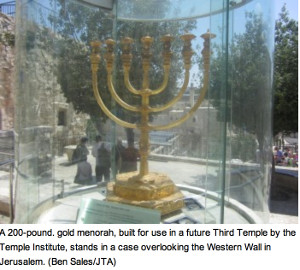
JERUSALEM (JTA) – No praying. No kneeling. No bowing. No prostrating. No dancing. No singing. No ripping clothes.
These are the rules that Jews must abide by when visiting the Temple Mount, the site where the First and Second Holy Temples once stood, located above and behind the Western Wall in the heart of Jerusalem’s Old City.
Although the area is under Israeli sovereignty, the mount — known to Muslims as Haram al-Sharif — is controlled by the Islamic Wakf, a joint Palestinian-Jordanian religious body. As the site of the Al-Aqsa Mosque and the Dome of the Rock, whose golden dome overlooks the city, the Temple Mount attracts daily crowds of Muslim worshipers.
Under Wakf regulations, Jews may only access the mount for 4 1/2 hours per day and are forbidden from praying there.
But when Rabbi Chaim Richman stands only feet from the Dome of the Rock, surrounded by Muslim visitors, he whispers a chapter of Psalms.
“God will answer you on your day of trouble,” he mutters on a recent visit. “The name of the God of Jacob will protect you.”
On previous visits to the mount, Richman says he’s sung the entire Hallel prayer under his breath.
A frequent presence on the mount who knows the guards by name, Richman is the international director of the Temple Institute, an organization based in the Old City with a singular goal: to rebuild the Holy Temple in Jerusalem.
Chaim Richman, international director of the Temple Institute, standing next to a replica of the holy ark at an exhibit of Third Temple vessels in the institute’s offices in Jerusalem. (Ben Sales/JTA)
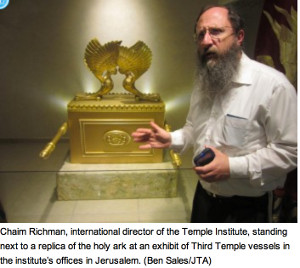
Ahead of Tisha b’Av, the fast day next week that commemorates the destruction of the First and Second Temples, the institute released a video showing Jewish children donning tool belts and leading their fathers out of synagogue to begin construction of the Holy Temple.
“Our goal is to fulfill the commandment of ‘They shall make a Temple for me and I will dwell among them,’ ” Richman says, quoting Exodus. “The basis of a Torah life is action.”
Following the Second Temple’s destruction in 70 C.E., most rabbis adopted the position that Jewish law prohibits reconstructing the Holy Temple prior to the age of messianic redemption, or that the law is too ambiguous and that the messiah must come first.
The Temple Institute takes a different position.
“There are no Jewish legal barriers” to rebuilding the temple, Richman says, only political ones.
The institute isn’t shy about advocating what many see as a radical goal: replacing the mosque at the Dome of the Rock with a new Jewish Holy Temple. A painting in the institute’s exhibition depicts this scenario, with the city’s light rail line taking residents to the Temple Mount. The Temple Institute is dedicated to laying the groundwork for this vision.
The organization has formulated a program for where the temple will stand and what its vessels will look like, aided by 20 men who study Temple law full-time. The products of this research — 40 ritual objects — are on display in Plexiglas cases at the institute’s headquarters in the Old City.
Silver trumpets to be blown by priests and a wooden lyre are perched next to two deep pans with long handles — one for collecting blood from small sacrificial offerings and another for large sacrifices like the Passover lamb.
The high priest’s diadem, created for use in a future third temple by the Temple Institute, at an exhibit of Third Temple vessels in the institute’s offices in Jerusalem. (Ben Sales/JTA)
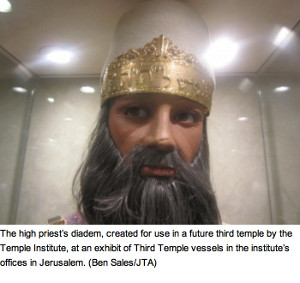
In another room, mannequins with beards wear the respective vestments for deputy priests and the high priest. The high priest’s outfit, with azure weaves, gold thread and a breastplate with 12 precious stones, took 11 years of research and $150,000 to complete. Next to it stands a massive 12-spigot sink with electric faucets — technology that Richman says will be permitted in the Third Temple.
The institute’s crowning achievement — the Temple’s golden, 200-pound, seven-branch menorah — stands outside in a case overlooking the Western Wall. Unlike art or history museums, the institute’s goal is to remove the objects from their cases and bring them to the mount for use as soon as possible.
Many Israelis view the goal as a danger to the status quo that has kept this site holy to Muslims and Jews from turning into a tinderbox.
In 1984, Israel’s security services stopped a group of Jewish terrorists conspiring to blow up the mosque at the mount who reportedly got very close to achieving their goal. Ever since, authorities say they have kept a close watch on any attempts to disturb the peace on the mount.
Though observant Jews pray thrice daily in the Amidah prayer for the Temple to be rebuilt, few do anything about it. That’s as it should be, says Michael Melchior, an Orthodox rabbi and former Knesset member who is considered a religious moderate.
“We pray for holiness, but we also need to be careful of others’ desire for holiness,” Melchior said. “The moment you want to translate that into building a Temple, you upset the sensitive balance we’ve created here, by which we exist here.” He called Temple construction advocates “irresponsible.”
Given the obstacles to breaking ground on a Holy Temple, the institute also has taken up a more modest cause: expanding Jewish rights on the Temple Mount to allow unrestricted access and prayer. In that endeavor, Richman is joined by several right-wing Knesset members and a group of archaeologists who say the Wakf is reckless with archaeological remains at the site.
A model of the Second Temple at an exhibit of Third Temple vessels in the Temple Institute’s offices in Jerusalem. (Ben Sales/JTA)
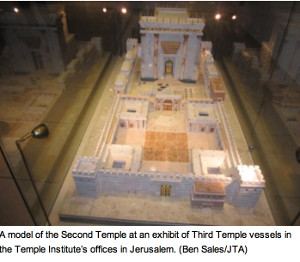
“It has exceptional historical importance,” Eilat Mazar, a Hebrew University archaeologist, said of the site. “There needs to be access for everyone. Authorities don’t take care of it.”
Moshe Feiglin, a nationalist Likud Knesset member, made a practice of visiting the Temple Mount monthly until Prime Minister Benjamin Netanyahu banned him from the site in order to prevent provocations there. Last month, Feiglin wrote on Facebook, “Whoever turns his back on the Temple Mount is also giving up on construction in the city.”
Richman says support for the institute’s goals is growing. For him, the issue involves far more than politics, archaeology or even Jewish legal research. The Temple Institute, he says, is doing God’s work.
“The point is that we can’t live without the Temple,” Richman says. “It’s not about building, it’s about a concept: the idea that all of human experience can be elevated to a sense of divine purpose.”
Until next week...keep on believing.
Almondtree Productions
“Seek
ye out of the book of the LORD, and read: no one of these shall fail,
none shall want her mate: for my mouth it hath commanded, and his
spirit it hath gathered them.”
(Isaiah 34:16)
click for page 2